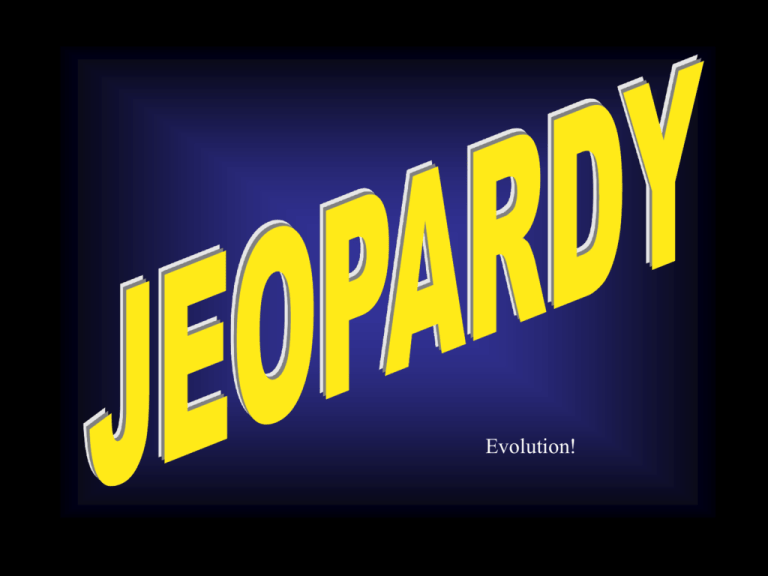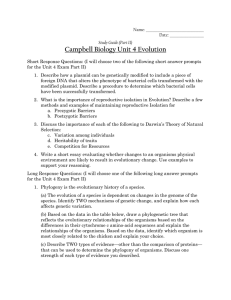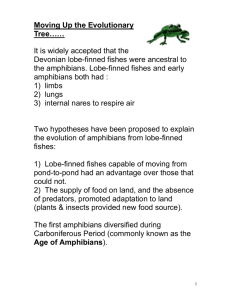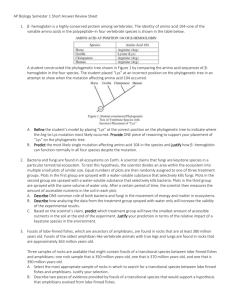Evolution Jeopardy
advertisement

Evolution! Evidence for Evolution Misc. Evolution Natural Selection Early Life on Earth $100 $100 $100 $100 $100 $200 $200 $200 $200 $200 $300 $300 $300 $300 $300 $400 $400 $400 $400 $400 $500 $500 $500 $500 $500 FJ Evolution $100 Question: Evolution happens to __________ not __________ Answer: Populations not individuals Evolution $200 Question: What is the definition of evolution Answer: Change in the frequencies of alleles in a population over time Evolution $300 Question: What are the 5 mechanisms that can cause evolution? Answer: 1. Genetic Drift (Chance events in a small population) 2. Non-Random mating (sexual Selection) 3. Mutations 4. Gene flow 5. Natural Selection (adaptations) Evolution $400 Question: Evolution can only occur if there is______ _______. Answer: Genetic Variety/Diversity Evolution $500 Question: The rapid evolutionary process by which many plant species have emerged Answer: Polyploidy Natural Selection $100 Question: What is the definition of Natural Selection? Answer: The survival and reproduction of the individuals that are genetically best fit for their environment Natural Selection Daily Double Question: The variety of dog and cat breeds that we have today are a product of _________ _____________. Answer: Artificial Breeding (Selective Breeding) $200 Natural Selection $300 Question: What are the 4 lines of evidence that support Darwin’s theory of natural selection? Answer: 1. Direct observation (peppered moth, drug-resistant bacteria) 2. Fossil record (Cetaceans transition from land to sea) 3. Homologous structures (Mammal arm bones, Heart chambers) 4. Biogeography (Matching continental drift with species divergence) Natural Selection $400 Question: How is the theory of natural selection different from Lamarck's theory? Answer: Lamarck: organisms acquire traits during their lifetime and then pass them on to their offspring. Darwin: Organisms are born with inherited traits. The traits that confer the ability to survive and reproduce are passed on Natural Selection $500 Question: A little child catches a fly and pulls its wings off. The fly actually lives a better life, but does not pass its lack of wings on to its offspring because the loss of wings is an _________ _______. Answer: Acquired Trait Early Life on Earth $100 Question: What are two structures and/or functions that are shared by all domains of life? Answer 1. DNA and RNA as carriers of genetic information through transcription, translation and replication 2. Major features of genetic code (ATGC, phosphate-sugar backbone, DNA polymerases) 3. Metabolic pathways (Kreb’s cycle, Glycolysis, photosynthesis in both pro- and Eukaryotes Primates Early life on Earth $200 Question: The line of evidence that nearly all of our understanding of the history of life depends on. Answer: The geologic and/or fossil record Primates Early Life on Earth $300 Question: The name of the experiment that demonstrated the possibility of abiogenesis Answer: Miller-Urey Primates Early Life on earth $400 Question: What are two structures and/or functions that are shared by all domains of life? Answer 1. DNA and RNA as carriers of genetic information through transcription, translation and replication 2. Major features of genetic code (ATGC, phosphate-sugar backbone, DNA polymerases) 3. Metabolic pathways (Kreb’s cycle, Glycolysis, photosynthesis in both pro- and Eukaryotes Primates Early Life on $500 Earth Question: The four steps through which the first cells were produced Answer: 1. Organic Monomers produced from inorganic precursors + Free Energy 2. Monomers synthesized into complex molecules including Amino acides and nucleotides 3. Packaging of polymers into protocells with lipid membrane 4. Origin of self-replicating molecules that allowed natural selection to occur. Evidence for Evolution Question: The hip bones of a dolphin and the tailbone of a human are examples of what? Answer: Vestigial Structures $100 Evidence for Evolution $200 Question: Give an example of a structure that is homologous to a cat’s paw. Answer: Answers vary. Dog’s paw, human arm, bat wing, whale flipper Evidence for Evolution Question: Give the definition of an analogous structure. Answer: Body parts that share a common function but have a different structure and evolutionary lineage $300 Evidence for Evolution Question: When two organisms share a large amount of similar DNA, what does that tell scientists? Answer: they are closely related $400 Evidence for Evolution $500 Question: In embryology, when the embryos are very similar to each other, this means… ? Answer: the organisms had a common ancestor Misc. $100 Question: What is the ability of an organism to survive and reproduce in its environment. Answer: fitness Misc. $200 Question: A group of organisms that can produce viable, fertile offspring are called this. Answer: A species Misc. $300 Question: Category and name of reproductive barrier in which reproduction is prevented by seasonal differences in mating Answer: Pre-zygotic, Temporal Isolation Misc. $400 Question: Why was the appearance of autotrophs on earth so important to life as we now know it? Answer: they produced oxygen that built up in our atmosphere Misc. $500 Question: 2 lines of evidence on which a phylogenetic tree can be created Answer: 1. Morphological similarities 2. DNA/Protein Sequence divergence Final Jeopardy Topic Evolution Final Jeopardy Question Fossils of lobe-finned fishes, which are ancestors of amphibians, are found in rocks that are at least 380 million years old. Fossils of the oldest amphibian-like vertebrate animals with true legs and lungs are found in rocks that are approximately 363 million years old. Three samples of rocks are available that might contain fossils of a transitional species between lobe-finned fishes and amphibians: one rock sample that is 350 million years old, one that is 370 million years old, and one that is 390 million years old. (a) Select the most appropriate sample of rocks in which to search for a transitional species between lobe-finned fishes and amphibians. Justify your selection. (b) Describe TWO pieces of evidence provided by fossils of a transitional species that would support a hypothesis that amphibians evolved from lobe-finned fishes.










